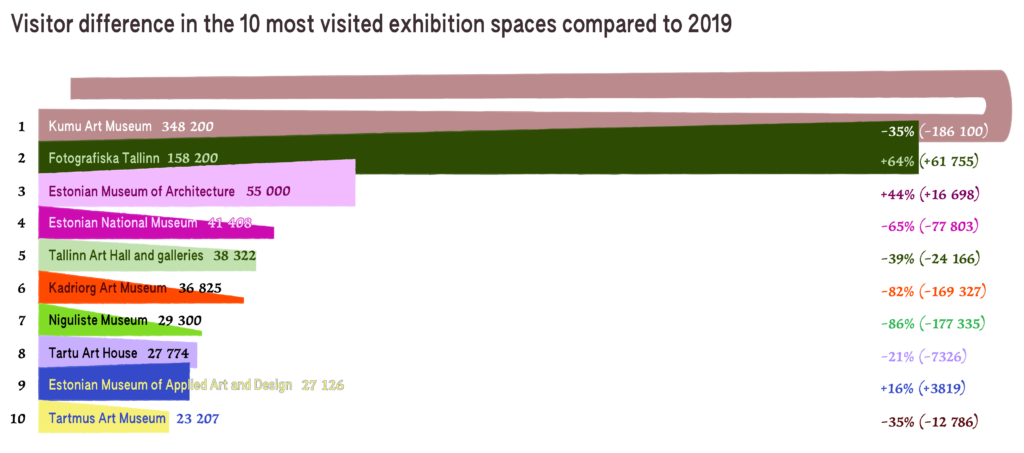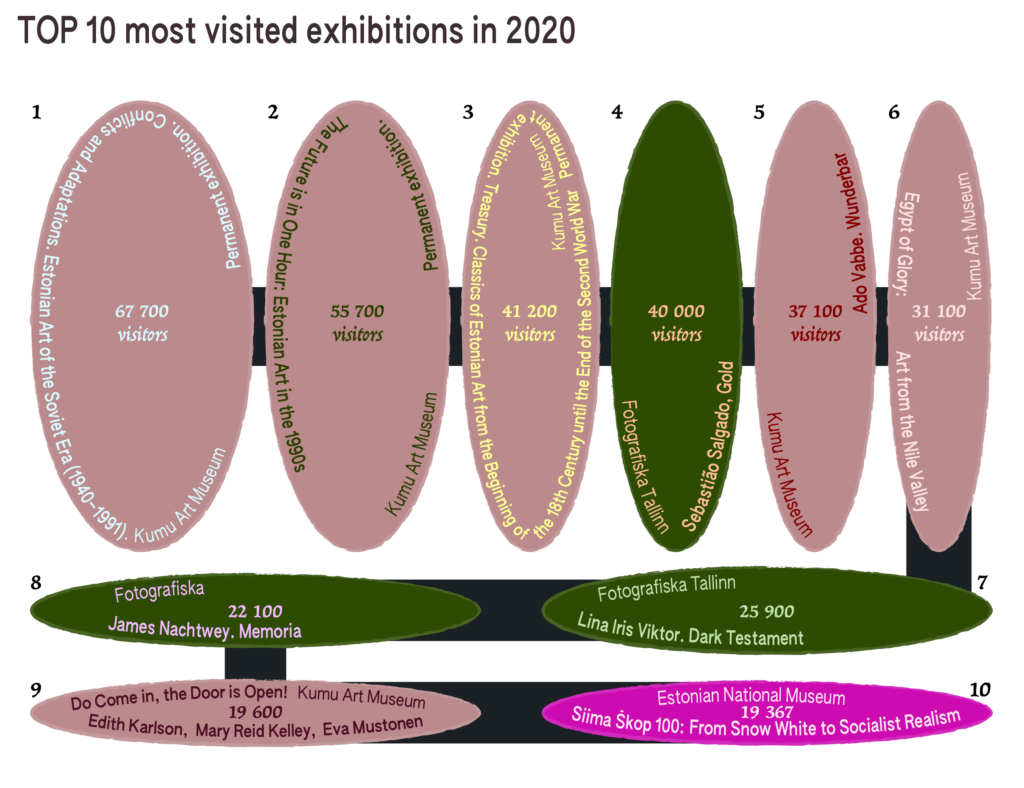Statistics: 2020 exhibitions in Estonia
In 2020, art exhibitions were held all over Estonia: all together in 21 cities, towns or villages. Statistics include information from 95 exhibition institutions located in Tallinn, Tartu, Pärnu, Haapsalu, Jõhvi, Jüri, Kärdla, Kuressaare, Narva, Paide, Põltsamaa, Rakvere, Rapla, Türi, Valga, Vaskjala, Viinistu, Viljandi, Varnja, Võru and Vana-Kasepää.
In 2020, a total of 807 art exhibitions took place, which is less than in 2019 (967 exhibitions). About half of these took place in Tallinn (382 exhibitions, 48 exhibition houses), followed by Tartu (140 exhibitions, 13 exhibition houses) and Pärnu with 52 exhibitions (5 exhibition houses). In 2020, out of the 807 exhibitions at least 128 included artists or curators based outside Estonia.

2020 will be remembered the most by the COVID-19 virus that escalated into a global pandemic in March of that year and led to substantial restriction of movement in public spaces as well in holding public events. The pandemic and the international and local travel restrictions left a visible mark on the visitor numbers of Estonian art institutions. Compared to 2019, the total number of exhibition visits dropped 46% during the first year of the pandemic. While in 2019 1 921 415 exhibition visits were made in Estonia, in 2020, the number dropped to 1 028 883 visits. This was especially visible in larger institutions, where a significant part of visitors is made up of an international audience. Out of the ten most visited institutions in Estonia, the highest percentage in decrease in visitor numbers happened at the two branches of the Art Museum of Estonia, the Niguliste Museum with a drop in visits by 86% (-177 335 visits) and Kadriorg Art Museum with a drop of 82% (-169 327 visits). In Tartu, compared to 2019, the visitor numbers dropped the most for the Estonian National Museum (decrease by 65%, -77 803 visits, Tartmus (35%, – 12 786 visits) and Tartu Art House (21%, -7326 visits).

The decrease caused by the pandemic does not reflect in the statistics of every institution. Compared to 2019, statistically the largest increase among the ten most visited institutions was made by Fotografiska Tallinn, open for its second year, with its visitor numbers increased in 2020 by 64%, i.e. 77 803 visits. The statistics also reveal an increase in the visitor numbers at the Estonian Museum of Architecture (44% increase, +16 698 visits) and the Estonian Museum of Applied Art and Design (16% increase, +3819 visits).
The most visited exhibitions still include the permanent expositions of larger exhibition houses, most likely due to the fact that these are open throughout the year. The top three most visited exhibitions include the permanent exhibitions at the Kumu Art Museum. Among changing exhibition, in 2020 the most visited exhibition was Gold by the photographer Sebastiao Salgado at Fotografiska, the second most visited show was Ado Vabbe’s solo exhibition Wunderbar at Kumu Art Museum and the third, the travelling exhibition Egypt of Glory: Art from the Nile Valley. All together the three most visited exhibitions (785 862 visits) make up 76% of the total number of visits in 2020.

In the 2020 and 2021 statistics, the data concerning language accessibility of exhibitions is highlighted. It shows that among the ten most visited exhibition spaces the ones that provide greatest language accessibility are Tallinn Art Hall and its galleries and Tartmus. In both institutions, all exhibitions (16 and 11, respectively) and the accompanying materials are provided in Estonian, English and Russian. When it comes to other exhibition institutions, language accessibility is lower – exhibitions with highest visitor numbers include materials translated mainly to English. At Kumu Art Museum, exhibition texts are available in Estonian and in English (with the exception of the permanent exposition Treasury. Classics of Estonian Art from the Beginning of the 18th Century until the End of the Second World War, partly also translated to German and Russian). The programmes at Fotografiska, Estonian National Museum and Tartu Art House are mainly in Estonian and English; at the Estonian Museum of Architecture and the Estonian Museum of Applied Art and Design are in Estonian and English but also partly Russian. Kondas Centre, an institution that is not among the top visited spaces, is nevertheless notable due to the fact that their programme is available in Estonian, English, Finnish and Russian.
Numbers included in the statistics give a great overview of the total number of exhibitions in Estonia and their distribution by location. Visitor numbers, however, are to a degree subject to speculation. This is due to many exhibition houses’ inability to count visitors. In larger exhibition spaces several exhibitions are open at the same time, however, they count the total number of visitors not the visitor numbers of each exhibition separately. As a result, we have presented exhibitions houses’ annual numbers as visits, not the total number of exhibition visitors.
The CCA has compiled data since 2016, when we started gathering and analysing exhibition related data from as many exhibition houses showcasing professional art as possible. Initially the aim was to map gender balance in the Estonian art scene. In the following years our data collection has expanded, now including number of exhibitions with participants form outside the country as well as visitor numbers. Statistical overview provides an important cultural political dimension to understanding local art field, providing data for analysing changes and developments occurring in the Estonian art field.